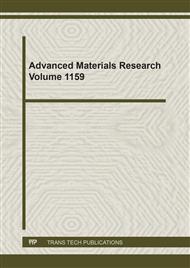[1]
Yun, Z, Mordechay, S, Milan, P (2011), "Tin and Tin Alloys for Lead‐Free Solder - Modern Electroplating, pp.139-204.
DOI: 10.1002/9780470602638.ch6
Google Scholar
[2]
Chidambaram, V., Hattel, J. and Hald, J. (2011), High-temperature lead-free solder alternatives,, Microelectronic Engineering, pp.981-989.
DOI: 10.1016/j.mee.2010.12.072
Google Scholar
[3]
M. L. Wu, C and Huang, M.L. and Lai, Joseph and Chan, YC (2000), Developing a lead-free solder alloy Sn-Bi-Ag-Cu by mechanical alloying, Journal of Electronic Materials, V 29.
DOI: 10.1007/s11664-000-0166-5
Google Scholar
[4]
Wei, L., Rong, A., Chunqing, W. and Yanhong, T. (2015), Effect of Au-Sn IMCs' formation and morphologies on shear properties of laser reflowed micro-solder joints,, Soldering & Surface Mount Technology.
DOI: 10.1108/ssmt-07-2014-0016
Google Scholar
[5]
Thomas.S, Stephen.L, David.R. S, Juan.C.M (2002), Database for Solder Properties with Emphasis on New Lead-free Solders, National Institute of Standards and Technology, Colorado School of Mines.
Google Scholar
[6]
Y. Yamagishi, M. Ochiai, H. Ueda, T. Nakanishi, M. Kitazima, Pb-free solder of Sn±58Bi improved with Ag, in: Proceedings of the 9th International Microelectronics Conference, 24±26 April 1996, Omiya, Japan, p.252± 255.
Google Scholar
[7]
Efzan Mhd Noor, E., Singh, A., & Tze Chuan, Y. (2013). A review influence of nano particles reinforced on solder alloy. Soldering & Surface Mount Technology, 25(4), 229-241.
DOI: 10.1108/ssmt-11-2012-0026
Google Scholar
[8]
Gain, A. K, Chan, Y.C and Yung, W.K.C. (2011), Effect of addition of ZrO2 nanoparticles on the microstructure and shear strength of Sn-Ag-Cu solder on Au/Ni metallized Cu pads, Microelectronics reliability, Vol.51 pp.2306-2313.
DOI: 10.1016/j.microrel.2011.03.042
Google Scholar
[9]
Ye, D., Du, C., Wu, M., & Lai, Z. (2015). Microstructure and mechanical properties of Sn–xBi solder alloy. Journal of Materials Science: Materials in Electronics, 26(6), 3629-3637.
DOI: 10.1007/s10854-015-2880-z
Google Scholar
[10]
Amares Singh, & Efzan, Ervina. (2015). A Study of Temperature, Microstructure and Hardness Properties of Sn-3.8Ag-0.7Cu (SAC) Solder Alloy. MATEC Web of Conferences.27.02003.10.1051/matecconf/20152702003.
DOI: 10.1051/matecconf/20152702003
Google Scholar
[11]
Izwan, Izrul & Saud, Norainiza & Mohd Salleh, Mohd Arif Anuar & Derman, Mohd & Mohd Said, Rita. (2016). Effect of TiO2 additions on Sn-0.7Cu-0.05Ni lead-free composite solder. Microelectronics Reliability. 65. 10.1016/j.microrel.2016.08.011.
DOI: 10.1016/j.microrel.2016.08.011
Google Scholar
[12]
El-Daly, A.A.; Elmosalami, T.A.; Desoky, W.M.; El-Shaarawy, M.G.; Abdraboh, A.M, (2014) Tensile deformation behavior and melting property of nano-sized ZnO particles reinforced Sn–3.0Ag–0.5Cu lead-free solder.Mater. Sci. Eng. A 2014,618, 389–397.
DOI: 10.1016/j.msea.2014.09.028
Google Scholar
[13]
Gain, A.K.; Zhang, L (2016). Interfacial microstructure, wettability and material properties of nickel (Ni) nanoparticle doped tin–bismuth–silver (Sn–Bi–Ag) solder on copper (Cu) substrate. J. Mater. Sci. Mater. Electron. 1–13.
DOI: 10.1007/s10854-015-4252-0
Google Scholar
[14]
Li, Q., Ma, N., Lei, Y., Lin, J., Fu, H., & Gu, J. (2016). Characterization of Low-Melting-Point Sn-Bi-In Lead-Free Solders. Journal of Electronic Materials, 45(11), 5800-5810.
DOI: 10.1007/s11664-016-4366-z
Google Scholar


